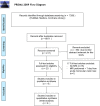Risk of acute stroke in patients with retinal artery occlusion: a systematic review and meta-analysis
- PMID: 31527762
- PMCID: PMC7093449
- DOI: 10.1038/s41433-019-0576-y
Risk of acute stroke in patients with retinal artery occlusion: a systematic review and meta-analysis
Abstract
Objective: To estimate the incidence of acute cerebral ischaemia detected by magnetic resonance imaging (MRI) in acute central retinal artery occlusion (CRAO), branch retinal artery occlusion (BRAO) and transient monocular vision loss (TMVL).
Methods: Studies reporting the incidence of acute cerebral ischaemia, detected by MRI, within 7 days from diagnosis of acute CRAO, BRAO and TMVL up to January 2019 were systematically searched for on Pubmed, Medline and Cochrane Library. Meta-analysis was performed using random effects model. The primary outcome was the pooled estimate of incidence of acute cerebral ischaemia in CRAO, BRAO and TMVL cohorts including both neurologically symptomatic and asymptomatic patients, expressed as a proportion along with 95% confidence intervals (CIs). The pooled estimate of incidence of asymptomatic acute cerebral ischaemia represented a secondary outcome measure.
Results: For the primary outcome, the pooled proportion of acute cerebral ischaemia was 0.30 (CI 0.24-0.36) in the CRAO cohort, and 0.25 (CI 0.16-0.37) in the BRAO cohort, without statistical heterogeneity. The rate of acute cerebral ischaemia was 11.8% in the TMVL cohort. For the secondary outcome, the pooled proportion of asymptomatic acute cerebral ischaemia was 0.22 (CI 0.16-0.28) in the CRAO cohort, 0.29 (CI 0.20-0.41) in the BRAO cohort and 0.08 (CI 0.05-0.15) in the TMVL cohort, with no statistical heterogeneity.
Conclusions: 30% of patients with acute CRAO and 25% of patients with acute BRAO presented an acute cerebral ischaemia on MRI. Such high rates support a care pathway of prompt referral of such patients for neurological evaluation and brain imaging.
Conflict of interest statement
The authors declare that they have no conflict of interest.
Figures
Comment in
-
Risk of acute stroke in patients with retinal artery occlusion.Eye (Lond). 2020 Jun;34(6):1149. doi: 10.1038/s41433-019-0715-5. Epub 2019 Nov 25. Eye (Lond). 2020. PMID: 31767959 Free PMC article. No abstract available.
-
Comment on: Risk of acute stroke in patients with retinal artery occlusion: a systematic review and meta-analysis.Eye (Lond). 2020 Dec;34(12):2349. doi: 10.1038/s41433-020-0796-1. Epub 2020 Feb 5. Eye (Lond). 2020. PMID: 32024973 Free PMC article. No abstract available.
References
-
- Easton JD, Saver JL, Albers GW, Alberts MJ, Chaturvedi S, Feldmann E, et al. Definition and evaluation of transient ischemic attack: a scientific statement for healthcare professionals from the American Heart Association/American Stroke Association Stroke Council; Council on Cardiovascular Surgery and Anesthesia; Council on Cardiovascular Radiology and Intervention; Council on Cardiovascular Nursing; and the Interdisciplinary Council on Peripheral Vascular Disease. The American academy of neurology affirms the value of this statement as an educational tool for neurologists. Stroke. 2009;40:2276–2293. - PubMed
-
- Park SJ, Choi NK, Yang BR, Park KH, Lee J, Jung SY, et al. Risk and Risk Periods for Stroke and Acute Myocardial Infarction in Patients with Central Retinal Artery Occlusion. Ophthalmology. 2015;122:2336–2343. - PubMed
-
- Arnold AC. Urgent evaluation of the patient with acute central retinal artery occlusion. Am J Ophthalmol. 2018;196:xvi–xvii. - PubMed
Publication types
MeSH terms
LinkOut - more resources
Full Text Sources
Medical




